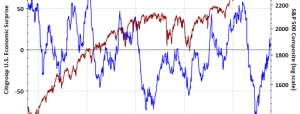Cisco Systems (CSCO) recently reported financial results for the third quarter of fiscal 2017.
The company’s bottom-line performance was robust. GAAP earnings-per-share increased to $0.50, a ~9% increase from the $0.46 recorded in the same period a year ago.
Adjusted financial results were almost as positive, with this quarter’s adjusted earnings-per-share of $0.60 representing a 5% increase from the $0.57 figure in the same period a year ago.
Despite this solid performance, Cisco’s stock was hammered following the announcement. The stock declined by nearly 8% on the day following the earnings release.
Looking more closely, Cisco’s stock price decline was driven by poor revenue growth and lackluster revenue guidance.
However, it appears that the markets are unfairly punishing this technology stock. Cisco is a mature business and has endured since its founding in 1984; 8% daily moves for a company of this size are almost unheard of.
Further, Cisco is very profitable and quite shareholder friendly. The company initiated its dividend in 2011 – preventing it from becoming a Dividend Achiever or a Dividend Aristocrat any time soon – but it has grown its payout immensely in that time.
So, by many measures, Cisco is a high-quality business. And, as we know…
“The best thing that happens to us is when a great company gets into temporary trouble…We want to buy them when they’re on the operating table.” – Warren Buffett
Fortunately for investors, Cisco is far from being ‘on the operating table’.
This article will outline the buying opportunity presented by Cisco’s recent stock price decline.
Business Overview & Current Events
Cisco is a diversified technology giant. The company was founded in 1984 and has grown to a market cap of $154 billion and quarterly revenues of $12 billion.
Cisco operates in 9 unique segments, which can be seen in the following diagram.

Source: Cisco Third Quarter Earnings Presentation, slide 6
Cisco is a highly globalized company. Approximately 40% of the company’s revenues are generated outside the United States.
This benefits Cisco because of the potential to penetrate new markets and increase its operational diversification.
However, when the U.S. dollar is strong against a basket of other global currencies (like it has been recently), Cisco’s international revenues become less valuable when swapped back to USD for reporting purposes. This can present a meaningful headwind to Cisco, depending on prevailing exchange rates.
The purpose of this article is to discuss the factors behind Cisco’s recent stock price decline.
As mentioned in the introduction, the main factor behind this price movement after Cisco’s earnings release was the announcements surrounding revenue.
Cisco’s revenues declined 1% from the same period a year ago. However, a 1% decline in quarterly revenue is relatively inconsequential considering that the company’s GAAP and adjusted earnings-per-share increased by 9% and 5%, respectively.
What really hurt Cisco’s stock price is its revenue guidance for the next quarter.
Cisco’s management team is expecting next quarter’s revenues to decline by 4%-6% from the same period a year ago.
This is very unusual for Cisco – the company has seen healthy revenue growth during most of its history as a publicly-traded company.
Cisco’s long-term annual revenue trend can be seen below.

Source: YCharts
So what are investors to make of Cisco’s reduced quarterly revenue guidance?
Well, it is very important to avoid looking at this revenue guidance in isolation. While revenue is important, there are other financial metrics (net income and free cash flow, for example) that provide other important information about a company’s financial health.







